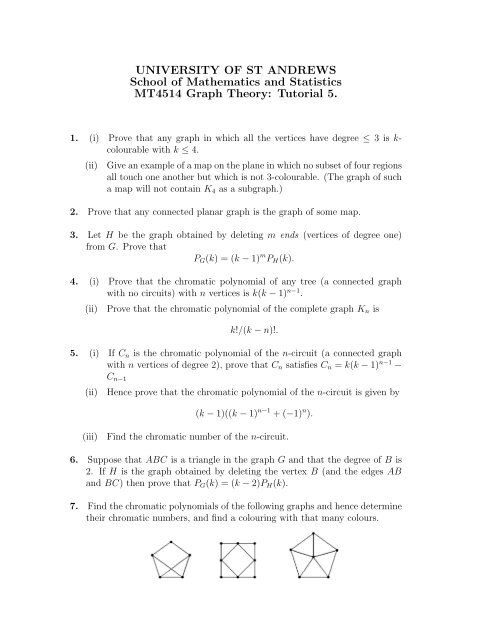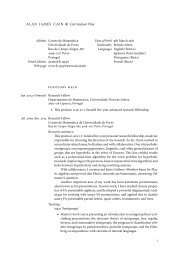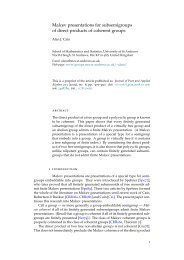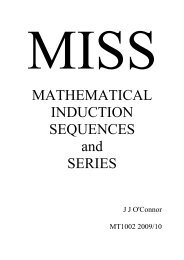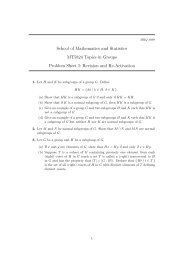Tutorial 5. - University of St Andrews
Tutorial 5. - University of St Andrews
Tutorial 5. - University of St Andrews
Create successful ePaper yourself
Turn your PDF publications into a flip-book with our unique Google optimized e-Paper software.
UNIVERSITY OF ST ANDREWS<br />
School <strong>of</strong> Mathematics and <strong>St</strong>atistics<br />
MT4514 Graph Theory: <strong>Tutorial</strong> <strong>5.</strong><br />
1. (i) Prove that any graph in which all the vertices have degree ≤ 3 is k-<br />
colourable with k ≤ 4.<br />
(ii)<br />
Give an example <strong>of</strong> a map on the plane in which no subset <strong>of</strong> four regions<br />
all touch one another but which is not 3-colourable. (The graph <strong>of</strong> such<br />
a map will not contain K 4 as a subgraph.)<br />
2. Prove that any connected planar graph is the graph <strong>of</strong> some map.<br />
3. Let H be the graph obtained by deleting m ends (vertices <strong>of</strong> degree one)<br />
from G. Prove that<br />
P G (k) = (k − 1) m P H (k).<br />
4. (i) Prove that the chromatic polynomial <strong>of</strong> any tree (a connected graph<br />
with no circuits) with n vertices is k(k − 1) n−1 .<br />
(ii)<br />
Prove that the chromatic polynomial <strong>of</strong> the complete graph K n is<br />
k!/(k − n)!.<br />
<strong>5.</strong> (i) If C n is the chromatic polynomial <strong>of</strong> the n-circuit (a connected graph<br />
with n vertices <strong>of</strong> degree 2), prove that C n satisfies C n = k(k − 1) n−1 −<br />
C n−1<br />
(ii)<br />
Hence prove that the chromatic polynomial <strong>of</strong> the n-circuit is given by<br />
(k − 1)((k − 1) n−1 + (−1) n ).<br />
(iii)<br />
Find the chromatic number <strong>of</strong> the n-circuit.<br />
6. Suppose that ABC is a triangle in the graph G and that the degree <strong>of</strong> B is<br />
2. If H is the graph obtained by deleting the vertex B (and the edges AB<br />
and BC) then prove that P G (k) = (k − 2)P H (k).<br />
7. Find the chromatic polynomials <strong>of</strong> the following graphs and hence determine<br />
their chromatic numbers, and find a colouring with that many colours.
8. Let G be a connected planar graph such that each region into which G divides<br />
the plane is bounded by a circuit <strong>of</strong> at least three edges. Show that:<br />
(i)<br />
if the faces <strong>of</strong> G can be 2-coloured then G is Eulerian<br />
(ii) if the faces <strong>of</strong> G can be 3-coloured and every vertex <strong>of</strong> G has degree 3<br />
then every face <strong>of</strong> G is bounded by an even number <strong>of</strong> edges.<br />
9. Use induction and the deletion-contraction property to show that the chromatic<br />
polynomial <strong>of</strong> a simple graph G with v vertices and e edges has the<br />
form<br />
P G (k) = k v − ek v−1 + lower order terms<br />
with the signs <strong>of</strong> the terms alternately + and − .


